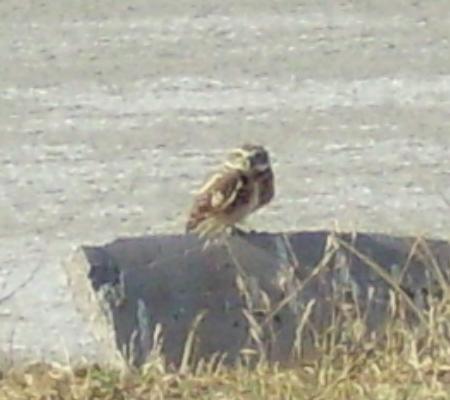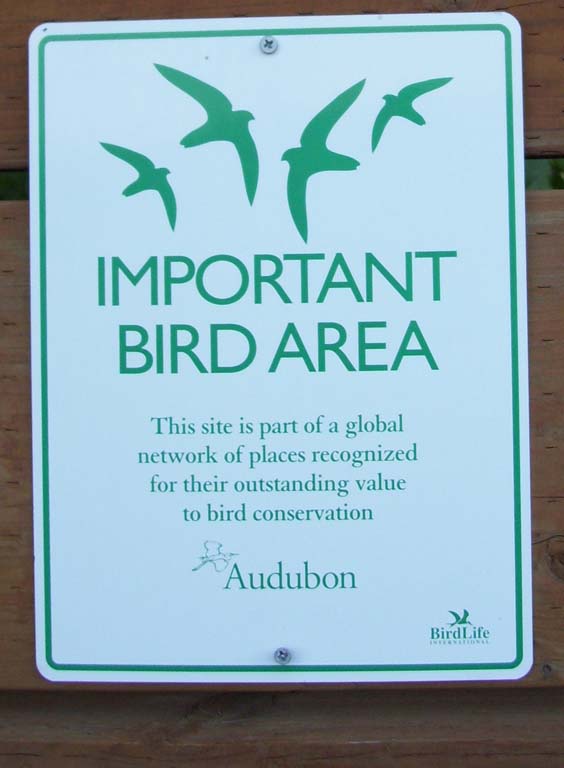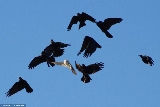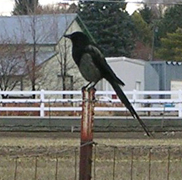
Courtesy Bridgerland Audubon Society
Lyle Bingham, Photographer
This is Dick Hurren from the Bridgerland Audubon Society.
During a recent field trip sponsored by our group, we saw two small burrowing owls with long legs and round faces, standing by their burrow, near the road, on a large stone.
A car stopped close by and the owls disappeared under the ground. Not wanting to disturb them, we stayed in our car to watch the pair. A few minutes later, after the other car left, one of the owls was back on the stone surveying the area and the other reappeared soon thereafter.
Burrowing owls are one of the less commonly seen of the 14 owl species found in Utah. With many former grasslands and prairies, the preferred habitat of these owls, now cities and cultivated farms, these protected birds have tried to adapt.
As their preferred habitats disappear, they may take up residence in cemetaries, golf courses, airports, on the edges of farms or in deserts. But their numbers are declining precipitously.
Most inhabit holes built by other animals. Occasionally, however, they burrow their own holes. For both nesting and off-season living, their preferred holes are bare of vegetation with a nearby mound. They stand on the mound mornings and evenings and hunt primarily nocturnally. Burrowing owls are often common near prairie dog towns and love to take over old prairie dog holes for their own. Where natural burrows are sparse and in winter, they may resort to using dry culverts under roads.
In spring, burrowing owls migrate north from the southerwestern states, that is Texas, New Mexico, Southern California, and Arizona. As well as parts of Mexico and from as far south as Honduras. Some travel as far north as Canada to nest. Most burrowing owls fly back south by the end of September, with the last leaving in October.
Weighing less than 6 ounces, this long-legged owl stands just 8 inches tall. The female incubates from 3 to 11 eggs while the male ferries in food to her for that 30-day period.
Their diet is diverse, a smorgasbord of invertibrates such as scorpions, grasshoppers, beetles, moths and worms as well as vertibrates like kangaroo rats, mice, frogs, snakes and lizards.
Both parents tend to the young until they fledge, at 40 to 45 days. In the burrow, the young can make a buzzy rattle-snake-like sound. This helps deter animals and humans from reaching in the hole to disburb them.
Land owners find that providing space for burrows or by building artificial burrows gives them, that is the landowners, the benefit of a voratious preditor of insects and rodents.
We can enjoy burrowing owls, and help reduce their declining numbers, when we preserve open spaces, restrict free-roaming dogs and cats, and restrict using pesticides that kill owls and the insects and small animals they eat.
For Wild About Utah I’m Dick Hurren.
Credits:
Photo: Courtesy Bridgerland Audubon Society, Lyle Bingham, Photographer, https://bridgerlandaudubon.org/
Voice Talent: Richard (Dick) Hurren, Bridgerland Audubon Society https://bridgerlandaudubon.org/
Text: Lyle Bingham, Bridgerland Audubon Society https://bridgerlandaudubon.org/
Additional Reading:
Woodin, M.C., Skoruppa, M.K., and Hickman, G.C., 2007, Winter ecology of the Western Burrowing Owl (Athene
cunicularia hypugaea) in Southern Texas 1999–2004: U.S. Geological Survey Scientific Investigations Report
2007–5150, 33 p. https://pubs.usgs.gov/sir/2007/5150/
https://pubs.usgs.gov/sir/2007/5150/pdf/SIR2007-5150.pdf
Romin, Laura A. and Muck, James A., Utah Field Office Guidelines for Raptor Protection from Human and Land Use Disturbances, Utah, Laura A. Romin and James A. Muck, U.S. Fish and Wildlife Service, Utah Field Office, May 1999,
https://fs.ogm.utah.gov/pub/MINES/Coal_Related/MiscPublications/USFWS_Raptor_Guide/RAPTORGUIDE.PDF
Burrowing Owl (Athene cunicularia), Factsheets, Hawkwatch International,
https://hawkwatch.org/learn/factsheets/item/827-burrowing-owl
Burrowing Owl, Utah Division of Natural Resources,
https://dwrcdc.nr.utah.gov/rsgis2/Search/Display.asp?FlNm=athecuni
Burrowing Owls, Burrowing Owl Preservation Society (California), https://burrowingowls.org/
Wright, Tony, A little owl makes a big journey, Wildlife Blog, Utah Division of Wildlife Resources, Utah Department of Natural Resources, https://wildlife.utah.gov/news/wildlife-blog/711-a-little-owl-makes-a-big-journey.html



